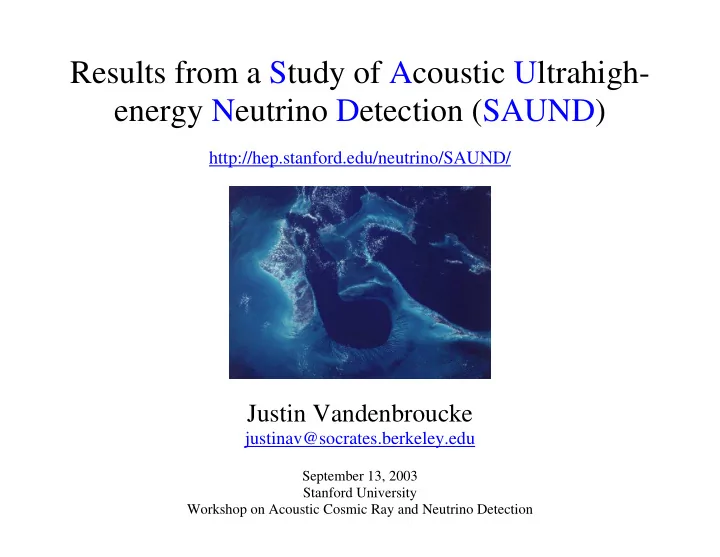

Results from a Study of Acoustic Ultrahigh- energy Neutrino Detection (SAUND) http://hep.stanford.edu/neutrino/SAUND/ Justin Vandenbroucke justinav@socrates.berkeley.edu September 13, 2003 Stanford University Workshop on Acoustic Cosmic Ray and Neutrino Detection
Andros Island, The Bahamas Stanford University Justin Vandenbroucke September 13, 2003
AUTEC hydrophone array SAUND Stanford University Justin Vandenbroucke September 13, 2003
Site 3 Stanford University Justin Vandenbroucke September 13, 2003
Site 3 Stanford University Justin Vandenbroucke September 13, 2003
DAQ system Stanford University Justin Vandenbroucke September 13, 2003
Calibration sources Stanford University Justin Vandenbroucke September 13, 2003
21 Events per lightbulb Stanford University Justin Vandenbroucke September 13, 2003
Light bulb positions and energies reconstructed Stanford University Justin Vandenbroucke September 13, 2003
Light bulb positions and energies reconstructed Stanford University Justin Vandenbroucke September 13, 2003
Detection contours under typical noise conditions Stanford University Justin Vandenbroucke September 13, 2003
Detection contours under typical noise conditions (zoomed in) Stanford University Justin Vandenbroucke September 13, 2003
Pancakes can be good Stanford University Justin Vandenbroucke September 13, 2003
AUTEC SVP Stanford University Justin Vandenbroucke September 13, 2003
Refraction is significant beyond 1 km Stanford University Justin Vandenbroucke September 13, 2003
Refraction is significant beyond 1 km Stanford University Justin Vandenbroucke September 13, 2003
Refracted pancake (undetected) 300 m deflection! Stanford University Justin Vandenbroucke September 13, 2003
Refracted pancake (detected) 100 m deflection Stanford University Justin Vandenbroucke September 13, 2003
Localization achieved Stanford University Justin Vandenbroucke September 13, 2003
Localization → energy reconstruction Stanford University Justin Vandenbroucke September 13, 2003
Cut 1: Digital Filter τ = 10 µ s Stanford University Justin Vandenbroucke September 13, 2003
Cut 3: Five-phone coincidence Require 1) Events obey causality: Pairwise, times are within coincidence window: t ij < c * d ij 2) Geometry consistent with pancake (2D circle) shape: accepted: rejected: Stanford University Justin Vandenbroucke September 13, 2003
Example of a five-phone event Stanford University Justin Vandenbroucke September 13, 2003
Example of a five-phone event Stanford University Justin Vandenbroucke September 13, 2003
Cuts 4a and 4b: Characteristic Frequency and Number of Periods Stanford University Justin Vandenbroucke September 13, 2003
Cut 4c: Diamond Events frequent but easily rejected with a matched filter (online?) Stanford University Justin Vandenbroucke September 13, 2003
Stanford University Justin Vandenbroucke September 13, 2003
Cut 5: Adaptive threshold Stanford University Justin Vandenbroucke September 13, 2003
Cut 6: Pancake shape constrains effective volume (bad news and good news) Stanford University Justin Vandenbroucke September 13, 2003
Cut 7: Threshold crossings Stanford University Justin Vandenbroucke September 13, 2003
Background rejection Cut Events passing cut (Run II, 163 days integrated livetime) 1) Filter trigger 40 million single-phone events 2) Electronic noise 25 million single-phone events 3) 5-phone coincidence 5 million combinations 4) Waveform analysis 3 thousand combinations a) Periods < 4 b) 20 kHz < freq < 40 kHz c) Diamond metric < 0.7 5) Threshold <= 0.024 6) 5-phone localization 300 combinations 7) Threshold crossings < 2 0 combinations (online, offline) Stanford University Justin Vandenbroucke September 13, 2003
What have we learned? - Refraction cannot be neglected for > ~ 1 km rays - Travel times are not significantly affected, but - Arrival direction and radiation envelope are (deflection) - Phones on sea floor are bad - Ray tracing necessary for localization - c sound = c light / 200,000 !! - Coincidence is a very weak requirement → combinatorics - 3D localization demonstrated - 10 m resolution attained - Array geometry important; planar array is worst case (but our signal is planar...) - Pancake shape a powerful requirement (despite decreased volume) - Impulsive backgrounds at 10 21 eV exist but can be rejected - Energy threshold is very high (10 21 eV) with 1.5 km spacing and current triggers Stanford University Justin Vandenbroucke September 13, 2003
What�s next? Analysis - Rigorous Monte Carlo efficiency check - Final flux limits SAUND-II - More phones, more volume, more computer processing - Improve adaptive threshold algorithm - Build coincidences online - Optimize cut strategy - Lower energy threshold (one order of magnitude reasonable) - Push to the Gaussian noise floor Beyond (other arrays) - 100-500 m spacing? - better geometry? - better noise environment? Stanford University Justin Vandenbroucke September 13, 2003
Recommend
More recommend